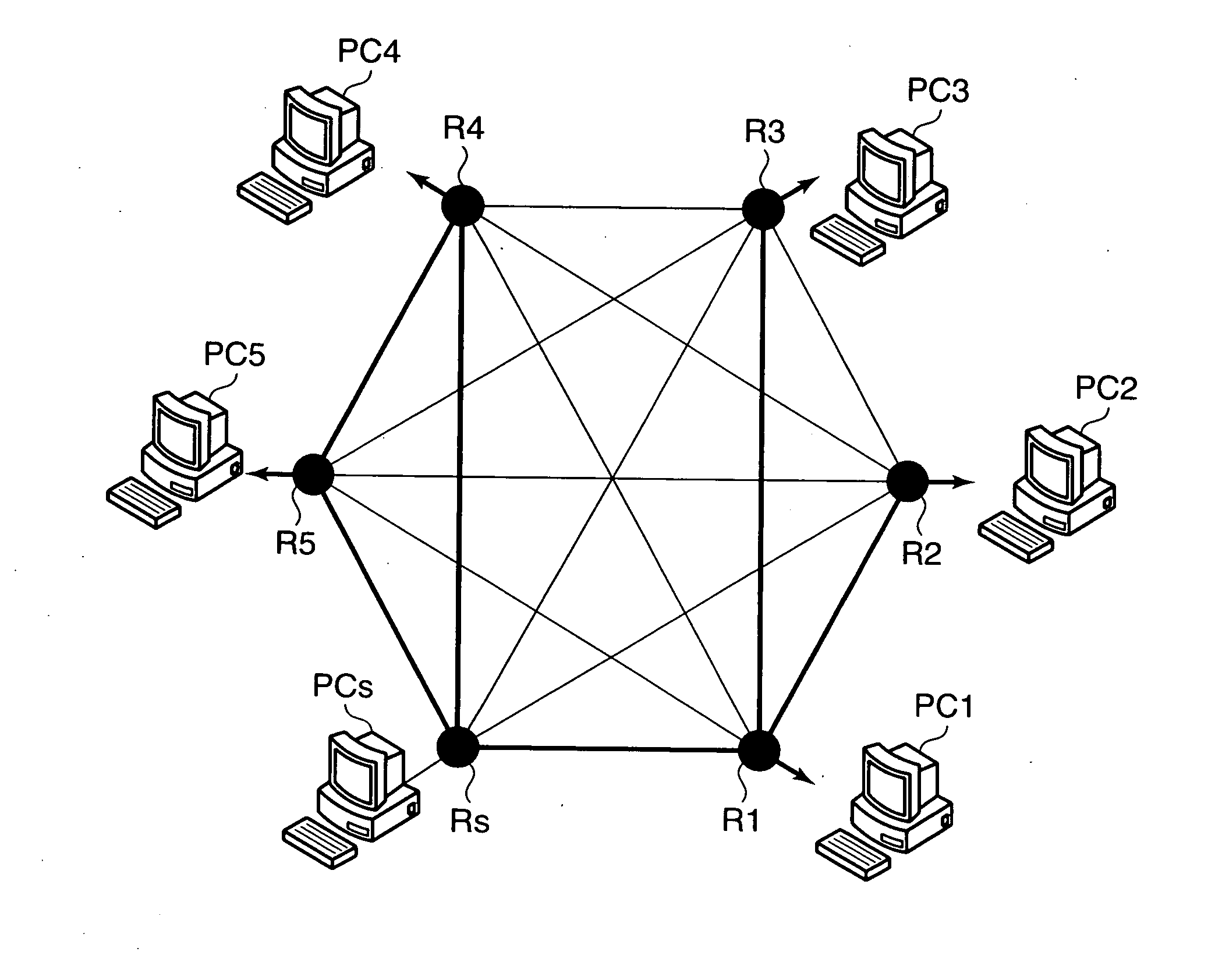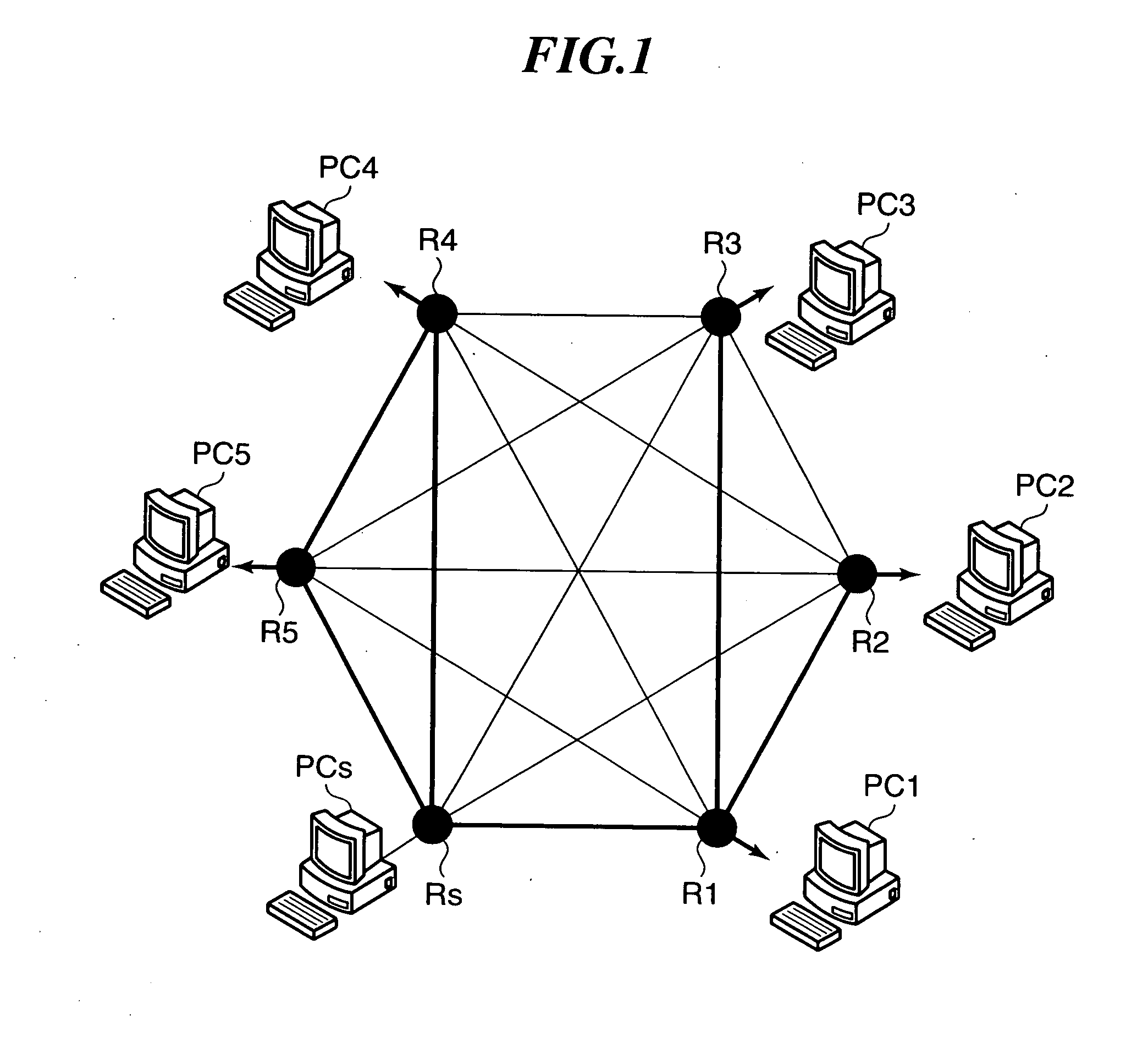[0007]With this construction, the distribution source router performs multicast distribution to distribution destination routers of a multicast group constructed on a
multicast network. The
multicast network is formed on a mesh virtual network. The distribution source router monitors a
CPU load ratio in the distribution source router, a communication characteristic of the multicast group, and a path characteristic of the mesh virtual network. The communication characteristic of the multicast group includes at least one of a bandwidth and a communication
delay thereof, and is calculated by monitoring packets for the multicast group. The path characteristic of the mesh virtual network includes at least one of a bandwidth and a communication characteristic thereof, and is calculated by monitoring packets flowing on the mesh virtual network. Further, the distribution source router stores the
CPU load ratio and the communication characteristic of the multicast group. In addition, the distribution source router starts reconstruction of a multicast
tree based on the path characteristic of the mesh virtual network and at least one of a result of comparison between the CPU
load ratio and a threshold value thereof and a result of comparison between the communication characteristic of the multicast group and a threshold value thereof. The distribution source router recreates a
routing table based on the reconstructed multicast tree. As a result, a multicast distribution path can be selected according to a load status of the distribution source router, the communication characteristic of the multicast group, and the path characteristic of the mesh virtual network. Therefore, multicast distribution can be carried out by selecting a communication path that satisfies a communication characteristic requested by the multicast group. Even if a large load is applied to the distribution source router due to, e.g., the increase in number of distribution of packets, the CPU
load ratio in the distribution source router can be maintained at or below a certain value (threshold value). Further, even if a communication
delay or the like is caused in a part of virtual path on the mesh virtual network due to, e.g., the increase in number of packets flowing on the mesh virtual network, multicast distribution is performed by selecting a path having a path characteristic margin, whereby multicast distribution can be performed without causing a communication delay or the like. In this manner, since load of the distribution source router and bandwidth load of an actual path constituting the mesh virtual network can be reduced, it is possible to ensure the
scalability of multicast distribution without the need of investment of hardware facilities for the distribution source router and the actual network.
[0009]With this construction, the distribution source router changes the number of branches and the depth of the multicast tree in a case where at least one of the CPU
load ratio and the communication characteristic of the multicast group exceeds the threshold value thereof. Based on the number of branches and the depth of the multicast tree after change and the path characteristic of the mesh virtual network, the distribution source router starts reconstruction of the multicast tree. With the reconstructed multicast tree,
multicast packets can be distributed via the distribution destination routers, without the need of directly distributing the
multicast packets from the distribution source router to all the distribution destination routers, whereby the load of the distribution source router can reliably be deconcentrated.
[0011]With this construction, each of the distribution destination routers implements the reconstruction of the multicast tree that specifies the packet distribution path from the distribution source router based on the number of branches and the depth of the multicast tree and the path characteristic of the mesh virtual network. The distribution destination router monitors the path characteristic of the mesh virtual network and decides the packet distribution path based on the path characteristic of the mesh virtual network. The distribution destination router implements the
recreation of the
routing table based on the reconstructed multicast tree. The multicast tree is completed when the
recreation of the routing tables for all the distribution destination routers are finished. Thus, the packet distribution path from the distribution destination router can be decided so as to select a communication path having a margin in consideration of the path characteristic of the mesh virtual network of the distribution destination routers. As a result, the distribution destination router is able to reduce a bandwidth load of an actual network that distributes multicast packets from the distribution destination router and constitutes the mesh virtual network, and it is therefore possible to ensure the
scalability of multicast distribution without the need of investment of hardware facility of actual network.
 Login to View More
Login to View More  Login to View More
Login to View More 


